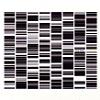Ryoji Ikeda, "Test Pattern"
 I have always enjoyed Ikeda's albums but never truly appreciated them until I saw a live performance by the man last year. Seconds into the performance I realized that I was listening to his albums at an unreasonably low volume. Afterwards I was sure to play his CDs at the appropriately loud level and they blossomed from being great examples of electronic music to being works of true beauty. This is the first release since that I have listened to properly from the first instant and it is a blinder.
I have always enjoyed Ikeda's albums but never truly appreciated them until I saw a live performance by the man last year. Seconds into the performance I realized that I was listening to his albums at an unreasonably low volume. Afterwards I was sure to play his CDs at the appropriately loud level and they blossomed from being great examples of electronic music to being works of true beauty. This is the first release since that I have listened to properly from the first instant and it is a blinder.
As per usual, the amount of information included with this album is minimal. Aside from recording dates, titles and the barcode art of the cover (interestingly there is no commercial barcode printed on the sleeve), the only concrete piece of information is that this is part of Ikeda’s ongoing Datamatics project. However, according to Ikeda’s own site:
“test pattern is a system that converts any type of data (text, sounds, photos and movies) into barcode patterns and binary patterns of 0s and 1s. Through its application, the project aims to examine the relationship between critical points of device performance and the threshold of human perception.”
What this means is very much up to the individual. Ikeda is famously silent about what is work means or could mean, leaving it up to each member of the audience (whether live or seated in their own homes) to come to their own conclusions. My opinions on Test Pattern are still in their formative state but my take home point, should you choose to accept it, is that Ikeda is highlighting that the vast majority of information out there is not in a format that we can understand. Barcodes and binary form the basis of communication in commerce and the world at large, these are machine-readable systems that cannot be understood directly by humans. First, by taking media familiar to us (such as film, sound and pictures) and converting them to this data format, Ikeda shows that no matter how realistic these images are, they are still just the edge of what we can experience (the 1s and 0s will always be alien). Secondly, by further converting these pieces of data into sound, he rehumanises the data and allows us to engage it in another way.
Philosophical blithering aside, it sounds exceptional. The aesthetic present on 2005’s Dataplex is instantly familiar but the music here is far more composed sounding: both deliberate and rhythmic. Some moments could easily be built up into dance tracks a la Autechre but the strange nature of data pulls it away from the brink. Played at the right volume, frequencies high, low, and everywhere in between stream from the speakers. The room rattles and the body tries to respond to the complex rhythms but gets knotted and lost. Each piece becomes steadily more complex, starting with a relatively short and simple “Test Pattern #0001” and peaking with the cluster-fuck of “Test Pattern #1101.”
In a career of consistent high quality, Test Pattern sticks out as being one of the more viscerally satisfying releases. Ikeda has cooked up a storm here but seeing that this part of the Datamatics project also exists as a live multimedia experience, I cannot help but feel that I am only seeing the tip of the iceberg. Considering the high power and resolution of modern home audiovisual equipment, I am surprised Ikeda has not explored the area of DVD further than he has. That being said, as long as he keeps releasing audio CDs like this, I’m not going to complain.
samples:



